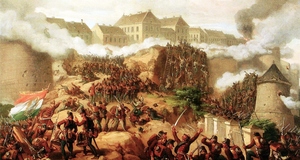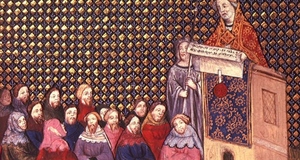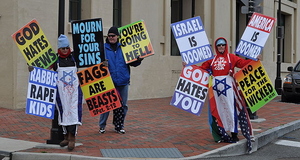Copernicus, Galileo, and the Church: Science in a Religious World
By
2011, Vol. 3 No. 05 | pg. 2/2 | « The Inquisition gave him a short amount of time to come to Rome or he would be jailed and brought when his health was better.22.) The entire trial lasted eight months, after which Galileo was sentenced by seven of the ten Inquisitors. The other three refused to sign for unknown reasons. His sentence was that Dialogues would be placed on the Index of Prohibited Books, Galileo could be arrested if the Inquisition decided so, he would have to publicly admit that he was wrong, and he would also have to perform religious penance for an extended amount of time. He was also placed under house arrest at the Embassy. He was allowed leniency because he admitted he violated the injunction but did not do so intentionally. Galileo was eventually allowed to return to his farm house to live out the remainder of his life. His book remained on the Index of Prohibited Books for many years after his death.23.) The committee that Pope Urban VIII organized had told the Pope that Dialogues could be corrected and then allowed to be published if any useful knowledge could be gained from it. However, the Pope did not allow this, possibly due to his irritation over Simplicio.24.) The Pope did not even allow Galileo a proper burial in a church; Galileo was buried in an unmarked grave in the Santa Croce Church in Florence. In 1734, ninety-two years after his death, a request was approved to give Galileo a better burial place, a mausoleum in the church he was originally buried in.25.) Dialogues remained on the Index for 111 years before a censored version was released, in 1744. The censored version was heavily edited, some sections were completely removed. It was finally removed from the Index 202 years later, in 1835.26.) For many years, the Catholic Church continued to deny that the Earth revolved around the Sun.It was only in 1820 that the Church allowed another astronomer, Joseph Settle, to declare the motion of the Earth, as proposed by Copernicus over 200 years ago, as fact. Three hundred and fifty years after Galileo's death, Pope John Paul II said in 1992 “that Galileo suffered unjustly at the hands of the Church and praised Galileo's religiousness and his views and behaviors regarding the relationship between science and religion.”27.) Copernicus received fairly positive recognition not long after his death. With the exception of his book being placed on the Index, there was little else that affected how people saw him. For some time after his death, he continued to receive praise for his other mathematical works.28.) In other countries, his heliocentric hypothesis was taught in some universities, arguments for and against being taught.29.) However, some were still critical of him. Tolsani wrote that Copernicus took the easy way by delaying publishing his book until he was on his deathbed, effectively escaping from the possible repercussions of the Church.30.) Perhaps Copernicus was right in delaying publication of Revolutions, for he feared the wrath of the Church. Scientists could not be sure that they were safe from criticism and religious persecution. ReferencesChristianson, J.R. “Copernicus and the Lutherans.” The Sixteenth Century Journal. Vol. 4, No. 2 (Oct., 1973) 1-10 Dobrzychi, Jerzy. The Reception of Copernicus' Heliocentric Theory. Boston: D. Reidel Publishing Company, 1972. Finocchiaro, Maurice A. The Galileo Affair. Berkeley: University of California Press, 1989. Grant, Edward. Science and Religion, 400B.C. – A.D.1550: From Aristotle to Copernicus. Westport: Greenwood Press, 2004. “400 Years of Galileo: Myths, Facts and Influence of a Renaissance Man.” Illinois Wesleyan University. June 10, 2009. March 25, 2010. Roland, Wade. Galileo's Mistake: A New Look at the Epic Confrontation between Galileo and the Church. New York: Arcade Publishing, 2003. Rosen, Edward. “Was Copernicus' Revolutions Approved by the Pope?” Journal of the History of Ideas. Vol. 36, No. 3 (Jul. - Sep., 1975) 531-542 De Santillana, Giorgio. The Crime of Galileo. Melbourne: Heinemann, 1958. Endnotes1.) Maurice A. Finocchiaro, The Galileo Affair. (Berkeley: University of California Press, 1989) 297. 2.) Edward Grant, Science and Religion, 400B.C. – A.D.1550: From Aristotle to Copernicus. (Westport: Greenwood Press, 2004) 82. 3.) “400 Years of Galileo: Myths, Facts and Influence of a Renaissance Man.” Illinois Wesleyan University. June 10, 2009. March 25, 2010. 4.) Finocchiaro 16. 5.) Edward Rosen, “Was Copernicus' Revolutions Approved by the Pope?” Journal of the History of Ideas. Vol. 36, No. 3 (Jul. - Sep., 1975) 538. 6.) Ibid. 537. 7.) Finocchiaro 302. 8.) Ibid. 303. 9.) Rosen 540. 10.) Ibid. 541. 11.) Wade Roland, Galileo's Mistake: A New Look at the Epic Confrontation between Galileo and the Church. (New York: Arcade Publishing, 2003) 201. 12.) Ibid. 196. 13.) Finocchiaro 260-261. 14.) Ibid. 278. 15.) Ibid. 304. 16.) “400 Years of Galileo: Myths, Facts and Influence of a Renaissance Man.” 17.) Roland 196. 18.) Finocchiaro 200-201. 19.) Roland 203. 20.) Giorgio de Santillana, The Crime of Galileo, (Melbourne: Heinemann, 1958) 210. 21.) Roland 203. 22.) Ibid. 205. 23.) Finocchiaro 307. 24.) de Santillana 211. 25.) Finocchiaro 307. 26.) Ibid. 307. 27.) Ibid. 308. 28.) J.R. Christianson “Copernicus and the Lutherans.” The Sixteenth Century Journal. Vol. 4, No. 2 (Oct., 1973) 6. 29.) Jerzy Dobrzychi, The Reception of Copernicus' Heliocentric Theory, (Boston: D. Reidel Publishing Company, 1972) 79. 30.) Rosen 540. Suggested Reading from Inquiries Journal
Inquiries Journal provides undergraduate and graduate students around the world a platform for the wide dissemination of academic work over a range of core disciplines. Representing the work of students from hundreds of institutions around the globe, Inquiries Journal's large database of academic articles is completely free. Learn more | Blog | Submit Latest in History |
















